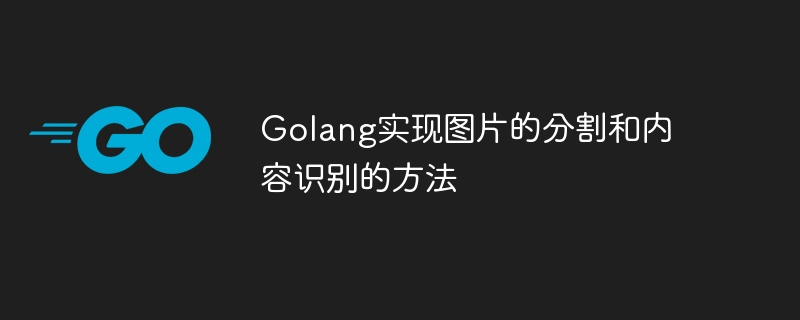Golang實作圖片的分割和內容辨識的方法

Golang實現圖片的分割和內容識別的方法
隨著人工智慧和電腦視覺技術的進步,圖片的分割和內容識別在各個領域中扮演著越來越重要的角色。本文將介紹如何使用Golang實現圖片的分割和內容識別的方法,並附帶程式碼範例。
在開始之前,我們需要先安裝幾個必要的Go套件。首先,我們需要安裝"github.com/otiai10/gosseract/v2",它是用於文字辨識的Golang函式庫。其次,我們還需要安裝"gonum.org/v1/gonum/mat",它是一個用於矩陣運算的Golang函式庫。可以使用以下命令進行安裝:
go get github.com/otiai10/gosseract/v2 go get -u gonum.org/v1/gonum/...
接下來,我們將透過以下步驟來實現圖片的分割和內容識別。
步驟一:讀取圖片並進行灰階處理
首先,我們需要從檔案中讀取圖片,並將其轉換為灰階影像。程式碼範例如下:
package main
import (
"fmt"
"image"
"image/color"
"image/jpeg"
"os"
)
func main() {
file, err := os.Open("image.jpg")
if err != nil {
fmt.Println("图片读取失败:", err)
return
}
defer file.Close()
img, err := jpeg.Decode(file)
if err != nil {
fmt.Println("图片解码失败:", err)
return
}
gray := image.NewGray(img.Bounds())
for x := gray.Bounds().Min.X; x < gray.Bounds().Max.X; x++ {
for y := gray.Bounds().Min.Y; y < gray.Bounds().Max.Y; y++ {
r, g, b, _ := img.At(x, y).RGBA()
grayColor := color.Gray{(r + g + b) / 3}
gray.Set(x, y, grayColor)
}
}
}在這段程式碼中,我們首先開啟並讀取了一張名為"image.jpg"的圖片。然後,我們透過"jpeg.Decode"函數將圖片解碼為圖像物件。接下來,我們創建了一個新的灰階影像物件"gray",並使用雙重循環將原始影像轉換為灰階影像。
步驟二:進行圖片的分割
在得到灰階影像後,我們可以使用一些影像處理演算法對圖片進行分割。這裡我們使用OTSU演算法進行閾值分割,程式碼範例如下:
package main
import (
"fmt"
"image"
"image/color"
"image/jpeg"
"math"
"os"
)
func main() {
// ...
// 分割图片
bounds := gray.Bounds()
threshold := otsu(gray) // OTSU算法获取阈值
binary := image.NewGray(bounds)
for x := bounds.Min.X; x < bounds.Max.X; x++ {
for y := bounds.Min.Y; y < bounds.Max.Y; y++ {
if gray.GrayAt(x, y).Y > threshold {
binary.Set(x, y, color.Gray{255})
} else {
binary.Set(x, y, color.Gray{0})
}
}
}
}
// OTSU算法计算阈值
func otsu(img *image.Gray) uint32 {
var hist [256]int
bounds := img.Bounds()
for x := bounds.Min.X; x < bounds.Max.X; x++ {
for y := bounds.Min.Y; y < bounds.Max.Y; y++ {
hist[img.GrayAt(x, y).Y]++
}
}
total := bounds.Max.X * bounds.Max.Y
var sum float64
for i := 0; i < 256; i++ {
sum += float64(i) * float64(hist[i])
}
var sumB float64
wB := 0
wF := 0
var varMax float64
threshold := 0
for t := 0; t < 256; t++ {
wB += hist[t]
if wB == 0 {
continue
}
wF = total - wB
if wF == 0 {
break
}
sumB += float64(t) * float64(hist[t])
mB := sumB / float64(wB)
mF := (sum - sumB) / float64(wF)
var between float64 = float64(wB) * float64(wF) * (mB - mF) * (mB - mF)
if between >= varMax {
threshold = t
varMax = between
}
}
return uint32(threshold)
}在這段程式碼中,我們定義了一個名為"otsu"的函數,用於計算OTSU演算法的閾值。然後,我們在"main"函數中使用該函數來取得閾值。接下來,我們建立一個新的二值影像"binary",並使用雙重循環將灰階影像進行閾值分割。
步驟三:進行內容辨識
在分割影像後,我們可以使用"gosseract"函式庫對各區域的內容進行辨識。程式碼範例如下:
package main
import (
"fmt"
"image"
"image/color"
"image/jpeg"
"os"
"strings"
"github.com/otiai10/gosseract/v2"
)
func main() {
// ...
client := gosseract.NewClient()
defer client.Close()
texts := make([]string, 0)
bounds := binary.Bounds()
for x := bounds.Min.X; x < bounds.Max.X; x++ {
for y := bounds.Min.Y; y < bounds.Max.Y; y++ {
if binary.GrayAt(x, y).Y == 255 {
continue
}
sx := x
sy := y
ex := x
ey := y
for ; ex < bounds.Max.X && binary.GrayAt(ex, y).Y == 0; ex++ {
}
for ; ey < bounds.Max.Y && binary.GrayAt(x, ey).Y == 0; ey++ {
}
rect := image.Rect(sx, sy, ex, ey)
subImg := binary.SubImage(rect)
pix := subImg.Bounds().Max.X * subImg.Bounds().Max.Y
blackNum := 0
for i := subImg.Bounds().Min.X; i < subImg.Bounds().Max.X; i++ {
for j := subImg.Bounds().Min.Y; j < subImg.Bounds().Max.Y; j++ {
if subImg.At(i, j) == color.Gray{255} {
blackNum++
}
}
}
if float64(blackNum)/float64(pix) < 0.1 { // 去除噪音
continue
}
output, _ := client.ImageToText(subImg)
output = strings.ReplaceAll(output, "
", "")
output = strings.ReplaceAll(output, " ", "")
texts = append(texts, output)
}
}
fmt.Println(texts)
}在這段程式碼中,我們使用"gosseract"函式庫中的"NewClient"和"Close"函數來建立和關閉識別客戶端。然後,我們使用雙重循環遍歷分割後的二值影像。對於非白色區域,我們取得該區域的座標範圍,並將其轉換為子影像。接下來,我們計算子影像中的黑色像素點佔比,以去除雜訊。最後,我們透過"ImageToText"函數將子圖像轉換為文本,並將結果保存在"texts"數組中。
透過上述步驟,我們已經完成了使用Golang實現圖片的分割和內容識別的方法。你可以根據自己的需求對程式碼進行修改和最佳化,以適應不同的場景和需求。希望本文能為你理解和應用圖片的分割和內容辨識技術提供一些幫助。
以上是Golang實作圖片的分割和內容辨識的方法的詳細內容。更多資訊請關注PHP中文網其他相關文章!

熱AI工具

Undresser.AI Undress
人工智慧驅動的應用程序,用於創建逼真的裸體照片

AI Clothes Remover
用於從照片中去除衣服的線上人工智慧工具。

Undress AI Tool
免費脫衣圖片

Clothoff.io
AI脫衣器

Video Face Swap
使用我們完全免費的人工智慧換臉工具,輕鬆在任何影片中換臉!

熱門文章

熱工具

記事本++7.3.1
好用且免費的程式碼編輯器

SublimeText3漢化版
中文版,非常好用

禪工作室 13.0.1
強大的PHP整合開發環境

Dreamweaver CS6
視覺化網頁開發工具

SublimeText3 Mac版
神級程式碼編輯軟體(SublimeText3)
 如何使用 Golang 安全地讀取和寫入檔案?
Jun 06, 2024 pm 05:14 PM
如何使用 Golang 安全地讀取和寫入檔案?
Jun 06, 2024 pm 05:14 PM
在Go中安全地讀取和寫入檔案至關重要。指南包括:檢查檔案權限使用defer關閉檔案驗證檔案路徑使用上下文逾時遵循這些準則可確保資料的安全性和應用程式的健全性。
 如何為 Golang 資料庫連線配置連線池?
Jun 06, 2024 am 11:21 AM
如何為 Golang 資料庫連線配置連線池?
Jun 06, 2024 am 11:21 AM
如何為Go資料庫連線配置連線池?使用database/sql包中的DB類型建立資料庫連線;設定MaxOpenConns以控制最大並發連線數;設定MaxIdleConns以設定最大空閒連線數;設定ConnMaxLifetime以控制連線的最大生命週期。
 如何在 Golang 中將 JSON 資料保存到資料庫中?
Jun 06, 2024 am 11:24 AM
如何在 Golang 中將 JSON 資料保存到資料庫中?
Jun 06, 2024 am 11:24 AM
可以透過使用gjson函式庫或json.Unmarshal函數將JSON資料儲存到MySQL資料庫中。 gjson函式庫提供了方便的方法來解析JSON字段,而json.Unmarshal函數需要一個目標類型指標來解組JSON資料。這兩種方法都需要準備SQL語句和執行插入操作來將資料持久化到資料庫中。
 Golang框架與Go框架:內部架構與外部特性對比
Jun 06, 2024 pm 12:37 PM
Golang框架與Go框架:內部架構與外部特性對比
Jun 06, 2024 pm 12:37 PM
GoLang框架與Go框架的差異體現在內部架構與外部特性。 GoLang框架基於Go標準函式庫,擴充其功能,而Go框架由獨立函式庫組成,以實現特定目的。 GoLang框架更靈活,Go框架更容易上手。 GoLang框架在效能上稍有優勢,Go框架的可擴充性更高。案例:gin-gonic(Go框架)用於建立RESTAPI,而Echo(GoLang框架)用於建立Web應用程式。
 從前端轉型後端開發,學習Java還是Golang更有前景?
Apr 02, 2025 am 09:12 AM
從前端轉型後端開發,學習Java還是Golang更有前景?
Apr 02, 2025 am 09:12 AM
後端學習路徑:從前端轉型到後端的探索之旅作為一名從前端開發轉型的後端初學者,你已經有了nodejs的基礎,...
 golang框架開發實戰教學:常見疑問解答
Jun 06, 2024 am 11:02 AM
golang框架開發實戰教學:常見疑問解答
Jun 06, 2024 am 11:02 AM
Go框架開發常見問題:框架選擇:取決於應用需求和開發者偏好,如Gin(API)、Echo(可擴展)、Beego(ORM)、Iris(效能)。安裝和使用:使用gomod指令安裝,導入框架並使用。資料庫互動:使用ORM庫,如gorm,建立資料庫連線和操作。身份驗證和授權:使用會話管理和身份驗證中間件,如gin-contrib/sessions。實戰案例:使用Gin框架建立一個簡單的部落格API,提供POST、GET等功能。
 Golang的目的:建立高效且可擴展的系統
Apr 09, 2025 pm 05:17 PM
Golang的目的:建立高效且可擴展的系統
Apr 09, 2025 pm 05:17 PM
Go語言在構建高效且可擴展的系統中表現出色,其優勢包括:1.高性能:編譯成機器碼,運行速度快;2.並發編程:通過goroutines和channels簡化多任務處理;3.簡潔性:語法簡潔,降低學習和維護成本;4.跨平台:支持跨平台編譯,方便部署。
 Go語言中哪些庫是由大公司開發或知名的開源項目提供的?
Apr 02, 2025 pm 04:12 PM
Go語言中哪些庫是由大公司開發或知名的開源項目提供的?
Apr 02, 2025 pm 04:12 PM
Go語言中哪些庫是大公司開發或知名開源項目?在使用Go語言進行編程時,開發者常常會遇到一些常見的需求,�...






